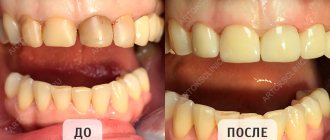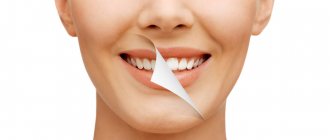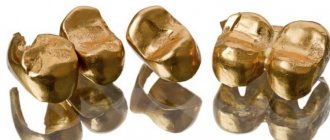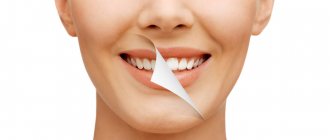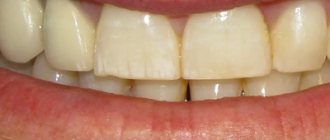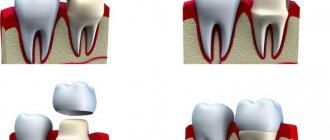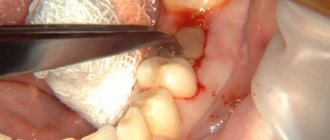1372
Materials for the manufacture of prosthetic structures are very widely represented on the pharmaceutical market.
Selecting the optimal composition for specific clinical conditions does not cause any particular difficulties.
Relatively recently, another material was added to composites, ceramics, metal and plastics - ceramic composite, or as it is also called, keromer or hybrid ceramics.
General overview
Dental ceramic composite is a material that combines the best properties and eliminates their main disadvantages.
The hybrid structure is used for the manufacture of crowns, inlays, veneers, bridges and occlusal onlays.
The term “ceramic composite” does not uniquely define the composition. The keromer may contain not only basic elements, but also other materials. If we approach the terminology strictly, then highly filled composites, in which ceramic particles are used as a filler, are essentially a hybrid form.
The material is presented on the market in the following forms:
- Photopolymerizable microhybrid composites .
These are viscous elastic compositions containing a polymer matrix and ceramic filler. A representative of this form is the Ceramage material - an ultra-fine substance (73% by weight) embedded in a polymer matrix. It is supplied in the form of sets with syringes containing compositions of different colors. - Hybrid polymer-ceramic machine blocks. Designed for use in CAD/CAM technologies. An example of such products are VITA ENAMIC machine blocks.
The material is a hybrid structure with matrices interpenetrating each other. Ceramics account for 86% by weight, polymer – 14%.VITA ENAMIC machine blocks are a completely finished material that does not require additional polymerization. The choice of block is made by color shade.
- Substance with fiberglass .
The latter serves as a frame. Fiberglass provides lightness, strength, and stain resistance. An example of this modification is the material FibreKor. Fiberglass instead of metal provides sufficient structural strength if the gap between the supporting teeth does not exceed 15 mm. - Metal-ceramic composite .
It is a mass deposited on a thin metal base (cobalt chromium alloy or zirconium oxide). Its structure is similar to metal-ceramics, with the only difference being that a ceramic composite is applied to the metal base, rather than pure ceramics.
The materials are light-curing (photopolymerizable). The main feature is elasticity, high resistance to cracking, edge stability.
Which method of prosthetics for periodontal disease is most effective.
Read here when it is justified to install half-crowns on teeth.
At this address https://www.vash-dentist.ru/protezirovanie/nesemnyie-p/koronki-np/pochemu-na-implante-shataetsya.html we will find out what to do if the crown on the implant is loose.
Comments
[…] oral cavity only as part of dentures: inlays, crowns, fillings, as well as implants. Metals react [...]
Galvanic syndrome or electric current in the mouth. What to do? (09/01/2018 at 09:02) Reply to comment
[…] for example, they compare favorably with metal and metal-ceramic products precisely from the point of view […]
Methods for making ceramic dentures. How are ceramic dentures made? (09/03/2018 at 09:00) Reply to comment
[…] bridge, this method does not involve installing crowns on the supporting teeth, and therefore is called gentle. They highlight […]
Methods of prosthetics without grinding teeth, descriptions, advantages and disadvantages (09/03/2018 at 09:03) Reply to comment
Write your comment Cancel reply
Application area
Ceramic composite crowns can be installed on vital and pulpless teeth, intracanal pins, core inlays, and on implants with delayed and immediate loading. They can also be the supporting part of a bridge.
The low weight of crowns makes them the preferred prosthetic option for express implantations. Low load on the implant creates good conditions for its primary stability and subsequent engraftment.
Dentists like the products because of their ease of manufacture and installation, and the ability to provide high aesthetics. If modeling is performed manually on a plaster model, the use of expensive equipment - firing furnaces, grinding and milling machine for CAD/CAM technology - is not required.
Dentures are installed using the classic adhesive method. At the same time, the glue not only fixes the structure, but also strengthens it, preventing the appearance of cracks.
Indications and contraindications
Prostheses can be used in the following cases:
- restoration of the coronal part of individual chewing and anterior teeth;
- prosthetics on implants;
- production of bridges with a length of up to 5 crowns, supported both by “native” teeth and implants.
Contraindications for the use of structures are:
- allergy to material components;
- inflammatory gum diseases (sanitation is required before installing a crown);
- age up to 15 years;
- bruxism;
- the patient's inability to provide good oral hygiene.
If the length of the bridge exceeds 5 teeth, it is necessary to use metal-ceramic or metal-plastic structures.
Most clinical cases allow the use of crowns made of different materials - composite, metal, ceramics, metal-ceramics, ceramic composite. The choice of a specific composition is dictated by the preferences of the doctor and the wishes of the patient.
The dentist’s duty is to introduce the dentist to the advantages and disadvantages of all options and their prices , so that the choice of a specific material is informed for the patient.
Who is suitable for composite crowns and bridges?
- For those who want a crown with the following properties: stronger than metal-free ceramics, but cheaper than zirconium dioxide - once; more aesthetically pleasing than metal ceramics, but cheaper than metal-free ceramics - two.
- Those who are missing one or more teeth;
- For those who have severely damaged teeth;
- For those who are allergic to metal;
- For those who do not have bruxism - night grinding of teeth. With constant jaw clenching, any crown covering will either crack or wear off over time. Therefore, for severe bruxism, two options are recommended - either facets or silicone aligners, which the patient will wear at night so that the new crowns last a long time.
Advantages and disadvantages
The products combine the advantages of ceramic and composite structures, and are free from some of their inherent disadvantages:
- High strength, both compressive and bending. Thanks to the elastic polymer matrix, the products are resistant to cracks and chips, which are typical for other structures.
They demonstrate high edge stability, where chipping is a recognized weak point of the pure substance. - Good aesthetics provided by the ceramics present in the material. The sets offer a wide range of shades to ensure complete color similarity between the crown and adjacent teeth.
- Excellent maintainability. A very important advantage that allows you to easily and efficiently repair a crown located in the patient’s mouth.
- Light weight compared to other masses.
- Color stability . Keromer is not subject to food coloring.
- Biocompatibility , extremely low allergenicity.
- Abrasion resistance due to the presence of a ceramic component. At the same time, there is no aggressive abrasiveness towards antagonist teeth.
- Manufacturability. Easy to model and manufacture due to ideal viscosity and good polishability.
- Versatility.
The products have a moderate price compared to purely ceramic products.
Flaws
- Shrinkage of the material , although small.
- Increased tendency for plaque to form on teeth due to the presence of organic material (polymer). Good oral hygiene is required.
- Adaptive abrasion. This is an ambiguous property, which on the one hand is positive (allows one to avoid abrasion of antagonists’ teeth), and on the other – negative, since the structure itself can be subject to abrasion by antagonists’ teeth.
- High price compared to metal-plastic crowns.
- Contraindicated for patients with bruxism and the possibility, although rare, of an allergy to plastic.
- The need for strong grinding of the tooth due to the significant thickness of the crown.
Why allergies to crowns occur and the symptoms accompanying the pathology.
In this publication you will find objective reviews about dental prosthetics in Heihe.
Follow the link https://www.vash-dentist.ru/protezirovanie/nesemnyie-p/kogda-opravdano-payanyimi.html if you are interested in the principle of manufacturing a soldered bridge prosthesis.
Manufacturing and installation features
Crowns are permanent structures, regardless of how they are used - covering individual teeth or as part of bridges.
Manufacturing
Two manufacturing technologies are used:
- Manual modeling using light-curing compounds. An example of such materials is the CERAMAGE microhybrid composite, consisting of ultrafine particles (73% by weight) and a polymer organic matrix (27%).
The process of making a crown involves taking impressions, making a plaster mold of the tooth being restored and its antagonists, and step-by-step (usually 3 layers) application of ceramic-composite paste with photopolymerization of each layer. Finally, the crown is polished. - Cutting (milling) a crown from a block using CAD/CAM technology. An example of this option is VITA ENAMIC technology. The machine blocks used as blanks consist of 86% ceramic and 14% polymer.
The cutting of the crown is carried out using a milling machine controlled by a special program. The pre-prepared tooth is scanned with a special camera to obtain a three-dimensional image of it with adjacent areas.The parameters of this image serve as input to the program that controls the milling machine. A crown cut in this way has the necessary strength and does not require additional polymerization.
The dentures are fixed using glue or composite. In addition to fixation, the adhesive composition ensures uniform distribution of the chewing load from crown to tooth.
Features of installation and repair
Products can be installed on a tooth with preserved dental nerve (vital pulp). Metal-ceramics, as is known, are fixed mainly only on a pulpless tooth, since the preserved nerve can become inflamed and require removal of the structure.
Can be installed together with an intracanal pin. If the upper part of the tooth is destroyed, but the condition of the tooth root is satisfactory, you can install a pin with a stump in the canal, on which to fix the crown. The advantage of this solution is the extension of the life of the tooth by 5 years or more.
Prostheses work well in combination with implants, including the immediate loading protocol. High strength, low weight, and good aesthetics of the hybrid material are a good addition to a well-installed implant.
The entire system can last up to 20 years or more, thanks to its good maintainability.
Zirconium crowns
This option is suitable for those who value the highest aesthetics, maximum strength, high wear resistance and durability. Such dentures are not created manually, but using milling and computer technology of the latest generation, therefore they repeat the structure with the highest accuracy and are also precisely positioned on the tooth. In addition, zirconium is completely compatible in its characteristics with the human body, has light transmission like natural teeth and is almost indistinguishable from the natural shade of enamel.
Zirconia crowns
Of course, you will have to pay many times more for zirconium dioxide crowns than for other prostheses - at least 12,000 rubles apiece, but they will justify their cost and will last about 20 years.
When choosing dental crowns, you should pay attention not only to the price, but also to other characteristics of the prostheses, to the appropriateness of their use for a certain clinical picture. Then the choice will be correct and will meet the main expectation from going to the dentist - getting a beautiful and functional smile.
Life time
It is believed that the service life of ceromer crowns is 10 years or more. However, they require careful care due to their tendency to form plaque. This involves brushing your teeth at least 2 times a day, morning and evening.
To completely remove food debris, it is advisable to use additional means for cleaning teeth - brushes, floss, irrigators. The latter are especially useful for gum inflammation, as they massage the tissue and improve blood circulation.
If cracks or chips form on the crown, they must be repaired immediately. Repairing the damage is a relatively easy operation, taking at most 1 hour.
To monitor the condition of the restored teeth, regular visits to the dentist are necessary.
What is a composite crown?
Composite crowns, like metal-ceramic crowns, consist of two components: a frame and a covering. The frame is made of hypoallergenic durable material of white or beige color, and is covered with a composite to match the color of the patient’s teeth. One of the most important advantages of a composite crown is that in the event of a chip (and chips can happen on any crown), it can be repaired in the doctor’s chair in 20 minutes. All other types of crowns must be removed from the mouth, taken to a dental technician and wait for repairs. Thanks to the light frame, composite crowns look natural. Like this:
The production time for a composite crown is the same as for a metal-ceramic crown. Unlike zirconium crowns, which are modeled by computer (which increases their cost and production time), we produce composite crowns in our dental laboratory. Here:
Comparison with metal-plastic
In terms of basic parameters, products made from this material are significantly superior to metal-plastic models in which the polymer is applied to a metal base:
- Life time. Metal-plastic crowns last no more than 5 years. Ceramic composite – at least 10.
- Preservation of aesthetic properties .
Metal-plastic materials retain their appearance unchanged throughout the year, after which it steadily decreases. Plaque accumulates and the crown darkens. Maintains appearance for a long time. With proper care, the material is not stained by food products and retains its original appearance indefinitely. - Maintainability . In both cases, it is high; the repair is performed in the patient’s mouth.
- The need for re-prosthetics when installed on an implant . A ceramic-composite prosthesis does not need to be replaced if the minimum period of absence of teeth is six months. Metal-plastic surgery requires mandatory re-prosthetics after 1-1.5 years or after a breakdown.
- Guarantee. For a ceramic-composite crown – 5 years, for a metal-polymer crown – 1 year.
Advantages and cost of a composite crown
It's time to supplement our list with a new type of crown - composite.
| Price (average for the Moscow region) for 1 crown | Advantages | Flaws | Service life (approx.) | |
| Metal ceramics | 4-7 thousand rubles | Durable classic | There is no transparency inherent in “natural” teeth Serious treatment of the tooth before installation | 6-10 years |
| Composite crown | 7-9 thousand rubles |
| Service life shorter than zirconia | 6-10 years |
| Metal-free ceramics | 12-16 thousand rubles | Perfect aesthetics | fragile | 2-5 years |
| Zirconium dioxide | 20-25 thousand rubles | Strength of metal ceramics + aesthetics of metal-free ceramics | Significant cost | 10-15 years |
Alternatives
If we assume that an alternative design should have the same weight and the same maintainability as a ceramic-composite one, then the only alternative is metal-composite crowns. This option is also applicable at the first stage of prosthetics on implants.
During the second stage of prosthetics, various alternative options are possible - for example, metal ceramics or zirconium crowns. But in terms of price, alternative solutions will cost more.
The video presents an expert's opinion on the material.
Ceramic composite crowns
Such crowns have excellent external characteristics, since they are created from a material that includes both ceramics and composite. They are hypoallergenic and do not cause irritation to the mucous membrane. A chipped composite can be easily adjusted right in the dental chair. Dentures will last up to 10 years.
Ceramic composite crowns
Crowns are less durable than metal-ceramics. Well suited for restoring teeth in the smile area. It is also an excellent option for implant-supported dentures. True, to acquire a “highly aesthetic” smile you will have to pay accordingly. Their price starts from 7,000 rubles.
Reviews
Not only crowns and bridges, but also veneers, inlays, and onlays can be made from ceramic composite.
If you have personal experience using these keromer products, please tell us about your impressions of them. You can do this by leaving a review at the bottom of this page.
If you find an error, please select a piece of text and press Ctrl+Enter.
Tags crowns fixed prosthetics
Did you like the article? stay tuned
Previous article
Purpose and types of denture bases
Next article
What does the smell from under the crown indicate and what to do
What is ceramic composite
Keromer for medical purposes is a material that has only the best qualities of the substances included in its composition and is devoid of their disadvantages. The material is used to create crowns, veneers, bridge systems and onlays. The main feature of the material is that it consists not only of basic substances, but also has impurities.
It is due to such mixed materials that crowns and dentures made from this substance are most reliable. High-quality material must necessarily contain particles of ceramics, which are used to create dentures and crowns. Otherwise, the admixtures added are extremely varied and depend on the type of ceramic composite.


